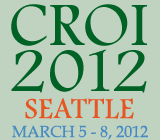 Despite rapid reductions in hepatitis C virus (HCV) levels in 10 previously treated null responders with genotype 1 HCV, only one person had a sustained virologic response (SVR), or viral cure, after treatment with a 12-week, pegylated interferon-free treatment regimen containing GS-7977 and ribavirin.
Despite rapid reductions in hepatitis C virus (HCV) levels in 10 previously treated null responders with genotype 1 HCV, only one person had a sustained virologic response (SVR), or viral cure, after treatment with a 12-week, pegylated interferon-free treatment regimen containing GS-7977 and ribavirin.
These results from the ELECTRON study, an ongoing Phase II clinical trial, were presented by Edward Gane, MD, of the Auckland City Hospital in Auckland, New Zealand, on Tuesday, March 6, at the 19th annual Conference on Retroviruses and Opportunistic Infections in Seattle.
Gane also reviewed preliminary data involving a group of people living with genotype 1 HCV starting treatment for the first time with GS-7977 plus ribavirin in the ELECTRON study. All study volunteers in this group had undetectable viral loads by the fourth week of treatment and have maintained these undetectable levels throughout therapy. Final results from this particular ELECTRON group are expected to be reported next month at the annual European Association for the Study of the Liver conference in Barcelona.
GS-7977—previously known as PSI-7977—is a once-daily nucleotide analog originally developed by Pharmasset, a company that was recently acquired by Gilead Sciences.
Strong results from another ELECTRON study group, involving people with genotype 2 or 3 HCV treated with 12 weeks of GS-7977 plus ribavirin, have been reported.
The ELECTRON data reviewed in full by Gane at CROI involved genotype 1 null responders—individuals who do not see their HCV viral load decrease by at least 2 log (at least 99 percent) after three months of therapy with pegylated interferon and ribavirin. Successful retreatment of null responders, even with a regimen containing a newly approved hepatitis C protease inhibitor, has been historically difficult.
The 10 null responders included in ELECTRON saw their HCV viral loads drop rapidly with a regimen of GS-7977 and ribavirin. All viral loads became undetectable by week four, which is termed a rapid virologic response (RVR) and is typically a strong predictor of curative treatment. These viral loads remained fully suppressed during therapy. However, all but one study volunteer experienced rapid rebounds in their HCV viral loads after finishing their 12-week treatment course.
The lone cure occurred in a young white woman who had minimal liver scarring and the IL-28B CC genotype, which is linked to a greater likelihood of being cured with interferon-based treatment.
Nobody discontinued treatment prematurely, and the adverse events were mild to moderate. One study participant experienced anxiety and depression, another developed anemia, and another—who was also taking the blood thinner warfarin—experienced a drop in platelets.
“Future studies of GS-7977 in the genotype 1 prior null responder population will likely require a longer duration of treatment, or the addition of another [direct acting antiviral,” Gane said.
Advertisement
Advertisement
Advertisement






Comments
Comments